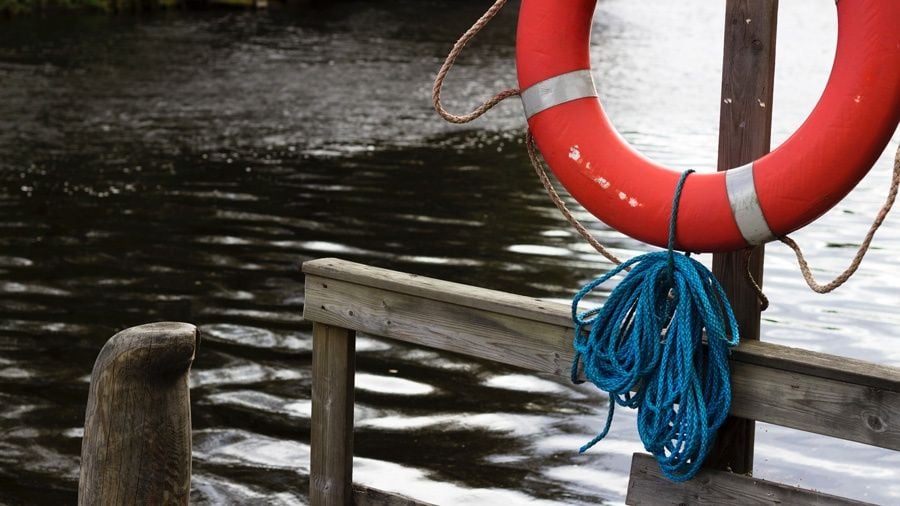
Is drowning really an issue?
Yes!
I know it's easy to think, "That only happens to other people." We get lazy. We make assumptions. But this is the absolute worst time to learn what they say about people who assume.
Drowning kills children under 5 years old more than anything else besides birth defects.
About 1 in 5 people who die from drowning are children 14 and younger.
For every child who dies from drowning, another 5 receive emergency department care for nonfatal submersion injuries.
We can prevent these tragedies by knowing both how to prevent potential issues beforehand and what to do if an accident does occur.
For an overview of pool safety for kids, check out this infographic from Mom Loves Best:

Prevention methods
Preventative measures are always your safest bet. It's so much better to put in the work to avoid an accident than to have to react to one as a rescuer.
- Teach children basic water skills and safety.
- Install a fence around your pool that completely separates it from the yard.
- Have children wear life jackets whenever they're in the pool area (whether they're in the water or not).
- Supervise children in the pool.
- Remove pool toys from the area when the pool isn't in use.
- Cover the pool when not in use.
- Don't drink alcohol in or around the pool (and don't let anyone else do it, either).
Teach kids basic water skills and safety
Everyone should know the basics of swimming. Even when children are too young to swim alone, hold on to them and teach them how to float and how to move through the water. It's often fun for the kiddos, and it could save their lives.
Water rescue: just jump in and pull them out of the water...right? Actually, it's not so simple. In 15 incidents in Australia from 2002–2007, 17 rescuers drowned while trying to rescue a drowning child. Do the math on that; at least one of those incidents featured multiple rescuers who became victims.
To help avoid such tragedies, everyone should know non-contact rescue skills—how to rescue and be rescued using by extending/grasping a rescue aid like a pole or rope and be guided to safety.
Teens and adults should also know how to perform cardiopulmonary resuscitation (CPR).
Install a pool fence
Install a four–sided isolation fence, with self–closing and self–latching gates, around backyard swimming pools. This can help keep children away from the area when they aren’t supposed to be swimming.
Pool fences should completely separate the house and play area from the pool.
Most areas of the US have local laws about pool fences, so check to make sure yours meets the requirements.
Wear life jackets
Make sure kids wear life jackets in and around the pool, even if they know how to swim.
This is especially important for weaker swimmers.
You should also have at least one buoyancy device nearby and ready to use. This is an actual safety device to help a drowning person stay afloat—not pool noodles, boogie boards, and floating toys.
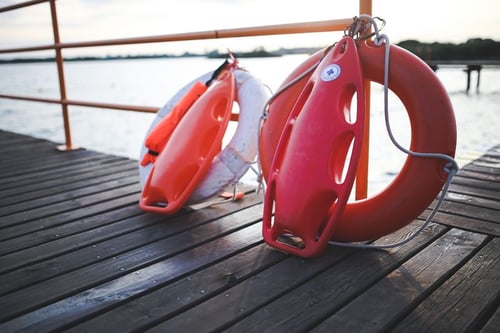
Supervise kids in the pool
If you want to get into the nitty-gritty, pool supervision has two distinct aspects:
- Never leave children alone in the pool.
- Actively supervise children in the pool.
"Never leave them alone," sure. Inconvenient, maybe, but fine. We can do that. It's the active supervision that takes a little more effort.
Drowning happens quickly and quietly, and 88% of kids' deaths in pools occur with some supervision. That terrifies me, honestly.
When kids are in or near water (including bathtubs), closely supervise them at all times. And multiple supervisors are always better than one.
Avoid distracting activities like playing cards, reading books, talking on the phone, napping, and using alcohol or drugs.
Put away pool toys when not in use
A cluttered deck is a tripping hazard, and it makes it difficult to move fast when you need to.
Kids also might be tempted to go into the pool area to get toys when a supervisor isn't around.
Cover the pool when not in use
Not only does this keep debris out of the water, but it can also prevent an accidental dunking.
If a child slips and falls into the pool outside of swim time, you might not see it happen—turning an "oops" into a real danger. A good pool cover (especially a sturdy one, like a vinyl security cover) can hold up against that weight, keeping your little one out of the water.
Don't drink alcohol
Neither swimmers nor supervisors should drink.
Alcohol slows reflexes and mental processes, impairing your ability to swim and to notice if someone is struggling in the water. You might not even realize it until it's too late.
What to do if a child has a swimming accident
In case an accident does happen, you need to act fast.
This will be much easier if you already know what to do:
- How to tell if a child may be drowning
- How to pull someone from the water safely
- How to perform CPR
Signs that a child may be drowning
Most drowning victims aren't dramatic. They don't shout or wave their arms. As in, they physically can't.
If you don't know what to look for, you might not even realize what's happening.
Learn to recognize the potential drowning signs:
- Mouth or head at the same level as the water
- Mouth is open and their head is back
- Eyes can’t focus
- Eyes are shut
- Hair is covering face, forehead or their eyes
- Gasping
- It looks like they are trying to climb a imaginary ladder
- They may try to assume the position of a back float
It may sound obvious, but one surefire way to know if they need help is to yell, "Do you need help?" A drowning person will usually not be able to respond at all.
How to pull someone from the water safely
The number one priority is to get the drowning child out of the water.
Now, the first instinct is often to jump right into the water and pull the child out—but in some situations, this could actually make matters worse. As with all rescue situations, you can't help the other person if you aren't safe.
Your best course of action is to toss them the buoyancy device we discussed earlier (non-contact rescue). This allows them to get their head above water and stay afloat, and you can guide them to safety from a distance without putting yourself at risk.
How to give CPR
You should know (or be learning) CPR—chest compressions plus mouth-to-mouth resuscitation. Take actual lessons, and keep your CPR certification up-to-date. I promise you that if you assume you'll know what to do, you will do it wrong if/when it truly matters.
Occasional gasping sounds DON'T COUNT as breathing.
- Make sure the scene is safe.
- Tap or shake the person and shout "Are you okay?" to ensure that the person needs help.
- Call 911.
- Open the airway. With the person lying on his/her back, tilt the head back slightly to lift the chin.
- Check for breathing. Listen carefully, for no more than 10 seconds, for sounds of breathing. If there is no breathing, begin CPR.
- Push hard, push fast, and count out loud. Place your hands, one on top of the other, in the middle of the chest. Use your body weight to help you administer compressions at least 2 inches deep, and at least 100 compressions per minute.
- Note: to help keep the proper tempo, you can do the compressions to the beat of "Stayin' Alive" (or, if your CPR instructor had a morbid sense of humor like mine did, "Another One Bites the Dust").
- Deliver rescue breaths. With the person's head tilted back slightly and the chin lifted, pinch the nose shut and place your mouth over the person's mouth to make a complete seal. Blow into the person's mouth to make the chest rise. Deliver two rescue breaths, then continue compressions.
- Note: If the chest does not rise with the initial rescue breath, re-tilt the head before delivering the second breath. If the chest doesn't rise with the second breath, the person may be choking. After each subsequent set of 100 chest compressions, and before attempting breaths, look for an object and, if seen, remove it.
- Continue CPR steps. Keep performing cycles of chest compressions and breathing until the person exhibits signs of life, such as breathing, an AED becomes available, or EMS or a trained medical responder arrives on scene.
Note: End the cycles if the scene becomes unsafe or you cannot continue performing CPR due to exhaustion.
How to buy a safe pool
While nothing can ever be 100% foolproof, you can choose a pool designed to help ease your worry.
At River Pools, we value your family's happiness and safety.
For example, a tanning ledge is an area where the water is only 8–12 inches deep. Kids and dogs can play safely, and you can rest in a lounge chair beside them while you supervise. We integrate this awesome feature into many of our fiberglass pools:
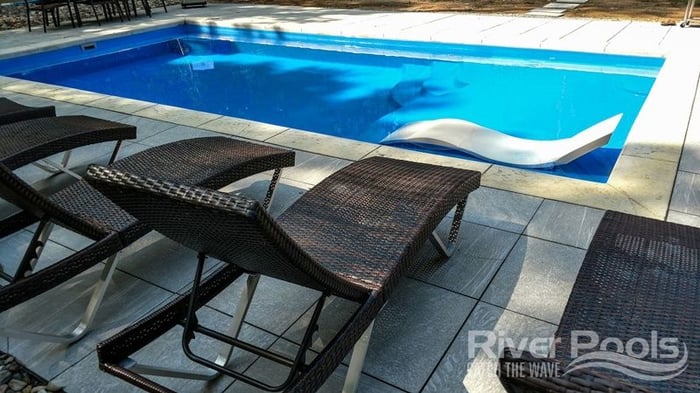
We can also manufacture and install a small, shallow tanning ledge distinct from the pool itself, which provides a separate place for small kids to splash and play.
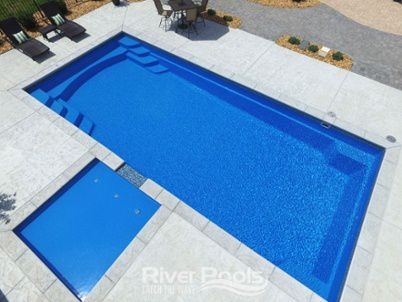
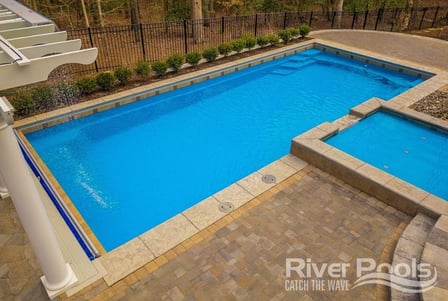
If you want a deep-end pool, we designed our T40 (8'6" deep) to have a small ledge along the sides for a grip if needed. The bench seats in each corner also work for both resting and exiting.
At River Pools, we manufacture world-class fiberglass swimming pools for installation across North America and have a wide variety of models to choose from.
If you'd like to learn more, feel free to get in touch with us. We'd love to answer any questions and help you on your pool journey!
Up Next: Thinking about hosting a pool party for your kids? Step up your game with Secrets to Hosting an Awesome Pool Party!
Editor's note: This blog article was updated on December 27, 2019
Editor's Note: This article was originally written by Holly Jender on May 24, 2018. Any opinions expressed are those of the author. Any prices referenced were based on information that was readily available at the time.
River Pools is a brand of inground fiberglass pools produced in a manufacturing facility in Fortville, IN. While our expertise is in manufacturing fiberglass pools, we have access to a network of installers with expertise relating to project design, installation, and pool service. We often tap into this knowledge base and share information freely with homeowners, just like you, considering installing a swimming pool in your backyard.
Topics:


